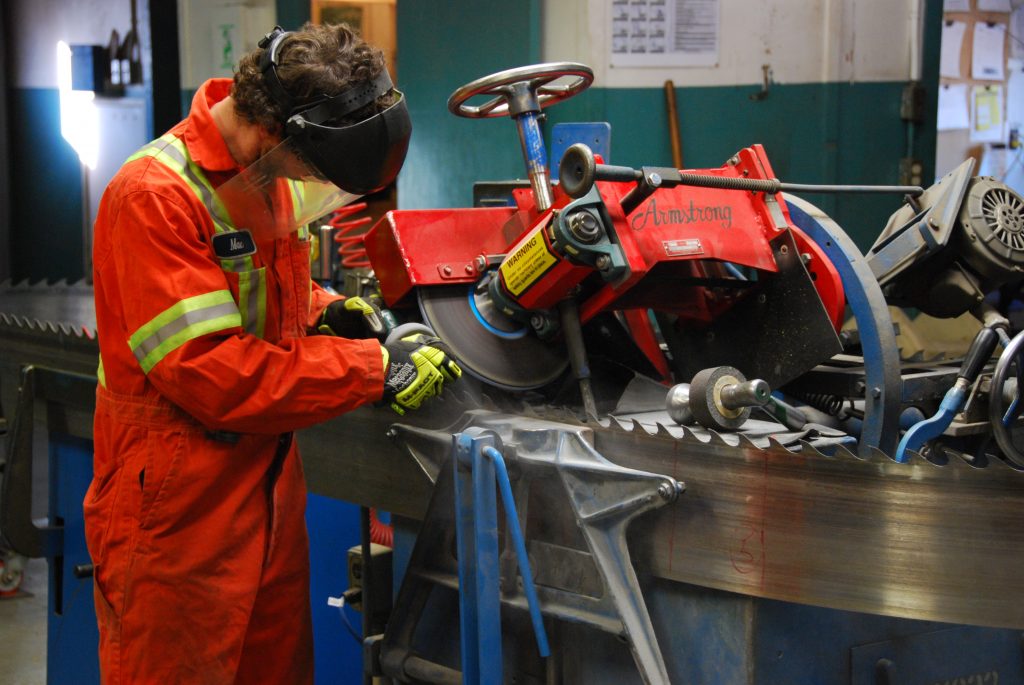
Features
Equipment
Sawmilling
Saw Filing 101: Dealing with new bandsaws
September 7, 2021 By Paul Smith
 Photo: Annex Business Media
Photo: Annex Business Media Although bandsaw manufacturers are very good at building and putting up bandsaws to your specifications, it is still well advised to go through a check-in process to fine tune and ensure that they are ready for your mill. Experienced filers will most likely always go over a new bandsaw before sending it out for its first run. A new bandsaw out of the crate should be put on the bench for inspection; filers should be looking for crate bends, checking the tension, tireline and the back. Every filer will tell you flatness is very important for a bandsaw and should be the first thing that is checked. Many filers will say, “There is no perfect saw and if you think you have found one, you just didn’t check it close enough.” Every mill is a little different and each may require the band to have different characteristics for a better run on the mill.
After checking and fine-tuning the band on the bench, it’s a good practice to inspect the teeth. Saw manufacturers normally will provide you with a good tooth with the intention of getting the first run without grinding the bandsaw. However, checking to make sure no teeth were damaged in the shipping process is a must. Saw manufacturers usually ship in open crates, making it possible for a tooth to become bent or even have corners knocked off if a forklift operator isn’t careful.
Customers have their own demands from saw manufacturers, and most manufacturers try their best to meet these demands. If you, as a customer, receive the bandsaw without shipping damage, are able to fine-tune it on the bench to meet your mill requirements in a minimum amount of time, get a good first run and are able to grind it in – again, in a minimum amount of time – after the first run, everyone’s a winner!
Mills allowing a break in period, not running the new saw as long on the first run, is pretty much a thing of the past. Most mills that I know no longer cut the run time short for the new bandsaw. Production needs trump being easy on a saw. Thankfully, because of quality steel and manufacturing, in addition to good sawfiling, new bandsaws are expected to run their full shift or until the normal saw change.
When ordering bandsaws, I think the old saying, “If it’s not broke, don’t fix it,” should apply. Just remember, saw manufacturers strive to give you a saw as close to your specs as possible. Good communication with your saw supplier will help get you the saw you and your mill require and expect. As all filers know, if you receive a band with too much back or too high of a tireline, the work can be very aggravating and time consuming. It’s a great idea to have these specs set up as a minimum and a maximum. Sawfilers can always add a little to the tireline, back and tension with ease as long as you have a good flat saw. Nothing should be pushed over the max from the manufacturer.
Hopefully, your new bands can be ground in within a few rounds around the grinder. If this is not the case, you should send a good sample section of a saw from your grinder to the manufacturer. It does not have to be more than eight to 10 inches long, as long as it covers a full section of teeth if you are running vari-pitch. A rubbing of your saw will do, but if you can supply a piece of the saw itself, you may find they are much more able to hit that target. It is also a good idea to keep your own section to compare when needed. The sample used must come from a well-kept or shaped grinding wheel. Keep in mind that your grinder should be up to spec and well-maintained to fit the new saw you have received.
The tooth can be one of the most important parts of the bandsaw and probably the easiest part of the bandsaw to get correct for the manufacturer. This is because of new technology in machinery that automates the process. The swage toothed band stands more likely to vary in size and shape because of wearparts in the machines. Check to make sure your tooth offset is within tolerance with a good-looking tooth and correct kerf. Thanks to the machinery used today, the bandsaw tooth should always be within specifications. Hard-tipped bandsaw teeth should be even easier for the manufacturer to get correct because of the quality bandsaw grinders they’re using.
Paul Smith is the owner and CEO of Smith Sawmill Service LLC with locations in Texas and Louisiana. Reach him at paul@smithsawmillservice.com.
Print this page